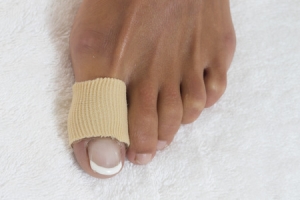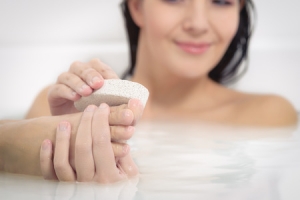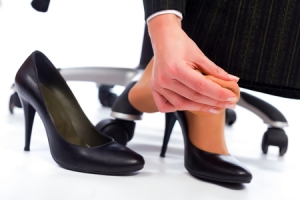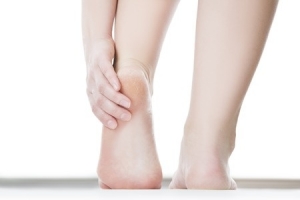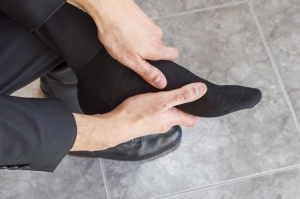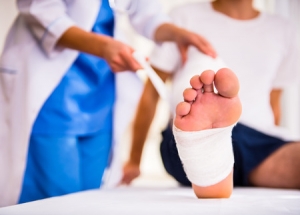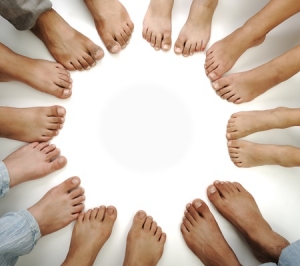Connect With Us
Blogs
Do’s and Don’ts for Dealing with Ingrown Toenails
It’s hard to believe how much pain such a tiny part of your body—a toenail—can cause, but if you have one that’s ingrown, you know what we’re talking about. The too-tender-to-touch, swollen, red, hot area surrounding your toe can make it difficult to wear shoes or even walk until it’s treated. At Superior Foot & Ankle Care Center we would like to offer the following tips for treating and preventing ingrown toenails:
Don’t: clip your toenails super short or file them with rounded edges—this encourages the nails to grow inward.
Don’t: wear shoes that are too small or narrow in the toe box. Ditto for socks and tights. Any type of footwear that forces the toes up against each other will increase the chances of ingrown nails.
Do: monitor a nail carefully if you’ve had an injury such as a heavy object fall on it, a bad stubbing or if you have another nail condition such as a fungal infection. In these cases, it is not uncommon for an ingrown nail to form.
Do: check your nails frequently if you are a runner, play soccer or participate in another activity where your toe is repeatedly being pounded up against the front of your shoe. This can cause a nail to become ingrown.
Do: soak your foot in warm water and Epsom salts if you notice a nail is ingrown. This may soften the skin enough so that you can gently massage the corner of the nail out of the skin. It may also bring pain relief.
Do: contact our Long Beach office for an appointment if soaking does not work. Our podiatrists, Dr. Victoria Foley or Dr. Constance Omelas will examine the nail and, if necessary, can perform a minor surgical procedure that will remove part of the nail border. Nails that are chronically ingrown may require the nail root to be removed.
Do: call us immediately at (562) 420-9800 if you notice signs of infection: pus, red streaks, fever.
Don’t: try any “bathroom surgery” or folk remedies to treat or prevent ingrown nails. Techniques like putting cotton under the nail, cutting a notch in a nail or repeatedly trimming nail borders as a new nail grows not only don’t work they can result in injury or infection.
5 Ways to Take Better Care of Your Feet
At Superior Foot & Ankle Care Center we believe in being proactive when it comes to the health of your feet. In honor of Foot Health Awareness Month, we’d like to offer the following tips for taking care of your feet:
- Wear shoes that fit. This is one of, if not the single biggest steps you can take to prevent foot and ankle injuries and disorders. Some studies have shown that up to 90% of people are wearing shoes that are the wrong size! Shoes that are too narrow or tight in the toe box can encourage deformities such as bunions and hammertoes as well as increase the risk of ingrown toenails and fungal infections. Get your foot professionally measured at the shoe store. Shoe size can change as you age and during pregnancy.
- Get in the habit of doing self-exams on your feet. Changes in the skin or nails of your feet, as well as shape, size or color, can all be indicators of potential foot problems. Any differences in sensation (burning, numbness, tingling), swelling or abnormal growths should be reported to our podiatrists, Dr. Victoria Foley and Dr. Constance Omelas promptly. Early detection of a foot problem can mean a better outcome and less invasive treatment.
- Limit time going barefoot. Bare feet in public places are at a higher risk for coming in direct contact with fungi and bacteria that cause infections such as athlete’s foot and fungal toenails. Even at home, however, going barefoot increases your risk of puncture wounds and injuries.
- Don’t neglect foot hygiene. Basic daily care of your feet should include washing with soap and water (and drying completely) as well as applying foot powder or moisturizing lotion, depending on your individual needs. Don’t wear socks more than one day and alternate our shoe choice as well.
- Live a Healthy Lifestyle. You may not think about it but maintaining a healthy weight, exercising and getting regular checkups all contribute to the health and well being of your feet. Be sure that you monitor chronic diseases such as diabetes and arthritis and follow your physicians’ instructions for keeping this conditions under control.
If you have questions about how to best care for your feet, contact our Long Beach office by calling: (562) 420-9800.
Neuromas: A Prevalent Problem Among Active Professional Women
At Superior Foot & Ankle Care Center we see a high incidence of neuromas among professional women for whom running is the fitness activity of choice. A neuroma is a disorder where a nerve becomes inflamed and enlarged causing symptoms of pain, burning and tingling. Patients with neuromas often say it feels like there is a rock in their shoe or that their sock is bunched up under their foot. Women who spend their workdays in heels and then pound the pavement running after work may be unknowingly putting an extreme amount of pressure on the ball of their foot. What’s the high heel/high impact running connection? High heels push your foot forward and narrow toe boxes squeeze toes together—both of which put excess stress on a nerve that is located at the base of your toes in the ball of your foot. Combine this stress with the added irritation of high impact and repeated force from running and you have the perfect conditions for a neuroma to develop.
Unfortunately, many women don’t pick up on these signs right away. The symptoms usually come on gradually and massaging the ball of the foot or changing your shoes for a day or two may relieve the pain—but only temporarily. In fact, the temporary nerve damage can become permanent if a patient does not seek professional podiatric treatment promptly.
Relieving Symptoms
You can’t see a neuroma on an x-ray or diagnose it with a lab test. Our podiatrists, Dr. Victoria Foley or Dr. Constance Omelas will examine the affected foot and palpate the nerve as well as ask questions about your symptoms and their duration to determine how far your condition has progressed. There are several treatment options available, including:
- Rest from activities that aggravate the foot
- Icing
- Over the counter anti-inflammatory medications
- Orthotic devices to reduce compression and increase support to the foot
Surgery is reserved for severe cases where other methods have not worked. If you wear heels, run and are experiencing any pain or odd sensations in the ball of your foot contact our Long Beach office for an appointment at your earliest opportunity by calling: (562) 420-9800.
5 Causes of Heel Pain
When your heel hurts, we at Superior Foot & Ankle Center know how limiting that can be on your day to day life. When every step is painful it’s difficult to walk, let alone work, shop, take care of children and household tasks or do any of the many other activities we normally take for granted. While resting your foot may temporarily ease heel soreness, permanent relief requires discovery of the source of the pain and developing a treatment plan that will address the root cause. Below are some common reasons for heel pain:
- Plantar fasciitis/heel spurs—this disorder is one of the most frequent reasons why patients experience heel pain. It occurs when the plantar fascia—a long band of tissue that stretches from your toes to your heel on the bottom of your foot—becomes injured or inflamed. If a patient is prone to plantar fasciitis they also have a greater likelihood of developing heel spurs, which are calcium deposits that build up in the heel and cause additional pain.
- The Wrong Shoes—sometimes eliminating heel pain is as simple as changing your shoes. Shoes that don’t provide adequate arch support or that position your foot in an abnormal way can inadvertently put extra pressure on your heel.
- Arch Issues—having flat feet or high arches alters the correct alignment of your feet with heel pain as a possible result.
- Calluses—these patches of hard, dry skin that appear on the surface of your heel are actually a sign of an internal irritation. The excessive pressure put on the heel by wearing high heels, being overweight, an altered gait or even the loss of the natural fat padding on your heel can all cause heel irritation which reveals itself in the callus.
- Nerve Problems—with disorders such as tarsal tunnel syndrome or Baxter neuropathy a compressed nerve in the foot or ankle can produce excruciating pain in the heel. If the pain is felt in both heels there is also a chance that the nerve issue is further up in the body in the spinal column.
Our podiatrists, Dr. Victoria Foley and Dr. Constance Ornelas will need to do a complete examination of your foot, ankle, and heel to diagnose the source of your heel pain. X-rays and other imaging studies may also be ordered. Once a diagnosis is confirmed, the foot doctor will be able to prescribe the correct treatment plan to resolve your heel pain. If you are experiencing pain in your heel, contact our Long Beach office by calling (562) 420-9800 today.
Could You Have Tarsal Tunnel Syndrome?
Do you experience a burning or tingling sensation that feels something like an electrical shock on the inside of your ankle bone? What about numbness or shooting pain in that area? If yes, you may be experiencing the symptoms of a condition known as Tarsal Tunnel Syndrome. At Superior Foot & Ankle Care Center we find that these symptoms can manifest in a number of ways. In some patients, they come on suddenly after a particularly strenuous workout session or after a long day of standing. The symptoms may also be experienced just in one spot or extend to the heel, calf, arch, and toes. This can make diagnosis a bit tricky because the symptoms are similar to those of several other podiatric conditions. Our podiatrists, Dr. Victoria Foley and Dr. Constance Ornelas will want to do a complete examination of your foot and ankle, checking for loss of sensation and trying to reproduce the symptoms you experience. Nerve conduction studies and advanced imaging studies may also be ordered.
Tracking Down the Source
The tarsal tunnel is literally a tunnel on the inside of your ankle that houses the posterior tibial nerve along with arteries, veins, and tendons. The tunnel is covered with a thick, protective ligament. Whenever something occurs that causes the nerve to be compressed the above symptoms can result. There are many different reasons for nerve compression:
- Flat feet—fallen arches cause the heel to turn outward which can put a strain on the posterior tibial nerve.
- Crowding—if an abnormal structure such as a ganglion cyst or a bone spur develops in the tunnel or a structure such as a tendon or varicose vein becomes enlarged it takes up more space in the tarsal tunnel, decreasing the amount of room for the nerves and other structures that belong in the tunnel. This causes the nerve to be squeezed or compressed.
- Injury—if you sprain your ankle or sustain another injury to that part of your foot the nerve may be compressed due to swelling or inflammation that occurs from the injury.
- Disease—certain diseases, such as diabetes and arthritis, also have swelling associated with them and will produce compression.
Once the foot doctor confirms a diagnosis of tarsal tunnel syndrome and determines the source the appropriate treatment can be prescribed. Left untreated the nerve damage can become permanent. So don’t delay—if you have symptoms, contact our Long Beach office at 562-420-9800.
3 Ways that Food Affects Your Feet
At Superior Foot & Ankle Care Center we know that the condition of your feet isn’t just about what goes on below your knees. Our podiatrists, Dr. Victoria M. Foley and Dr. Constance Ornelas believe that the health of the rest of your body plays a significant role in podiatric concerns. In honor of National Nutrition Month, we want to highlight the importance of proper eating and how it relates to your feet. Below are 3 ways that your diet can improve the health of your ankles and feet.
- Avoid Diabetes—diabetes, which afflicts over 30 million people in the U.S., affects your body’s ability to properly use or produce insulin resulting in high blood sugar levels. Diabetes reduces circulation and can cause neuropathy (loss of sensation) leaving your feet vulnerable to wounds and ulcers that can lead to infections and even possible amputation. The good news is you can prevent or significantly delay the onset of the most common form of this disease, Type 2 diabetes, with physical activity and modifications to your diet, including:
- Cutting way back on foods high in added sugar such as sodas and refined, processed foods
- Increasing the number of fruits, vegetables and whole-grain foods you consume every day
- Switching to healthier sources of fat such as olive and canola oil, nuts and avocados and avoiding saturated fats
- Prevent Gout Attacks and Inflammation—for patients who suffer from gout food is often what triggers an attack. Avoiding shellfish, red meat, beer, red wine, organ meats and heavy sauces can help you steer clear of this extremely painful joint inflammation which often happens in the big toe or ankle. Inflammation in, general, can be reduced by eating more berries, fish, and nuts high in omega 3 fatty acids, green vegetables, and olive oil, while steering clear of white sugar, fried food and refined flours.
- Decrease Your Risk of Foot Disorders—what do arthritis, plantar fasciitis, stress fractures and flat feet all have in common? The risk of developing one of these podiatric disorders as well as the severity of their symptoms are all increased by being overweight. There are many strategies for reducing and maintaining a healthy weight:
- Using smaller plates to automatically reduce portions
- Consulting a nutritionist or registered dietician to develop a healthy food plan
- Eat smaller portions more frequently instead of big meals
If you have questions about how changing your diet could impact a chronic foot condition contact our Long Beach office at 562-420-9800.
Post Op Pointers for Speedy Healing
At Superior Foot & Ankle Care Center we are committed to helping patients obtain relief from foot and ankle disorders using the least invasive methods possible. Sometimes, however, when conservative methods fail to give good results or a condition has progressed to a certain point, surgery is the best treatment option. Whether your surgery is to correct a bunion or help with flat feet, plantar fasciitis or another podiatric condition, what happens after the surgery is critical to completing the healing process. Below are some areas you should focus on if you are planning or have recently had podiatric surgery:
Plan Ahead—our feet are so crucial to daily living and yet we often take them for granted. If you will be unable to walk, even for a short period of time, you will need to put certain things into place prior to surgery:
- See that the area where you will be recovering has everything in easy reach—T.V. remote, books, water, phone, etc. If you sleep upstairs, you may need to set up a temporary bedroom on your main floor.
- Accept all offers of help for meals, running errands or caring for children.
- Clear your calendar of work and other appointments and obligations. Regardless of mobility, you will need rest immediately after surgery.
Wound Care—one of the most critical aspects of surgical recovery is preventing an infection from developing. Be sure you understand and follow all your foot doctor’s instructions for keeping surgical wounds clean. If you notice any signs of infection—warmth at the site of the surgery, redness or red streaks around the wound or fever—contact our podiatrists, Dr. Victoria Foley or Dr. Constance Omelas, immediately, even if it is after regular office hours.
Follow Through—don’t be your own foot doctor! Follow all of the podiatrist’s guidelines for your recovery and complete the full course of any physical therapy that is prescribed. Too often patients will discontinue therapy when they are feeling pain-free, but particularly for foot and ankle injuries strengthening of surrounding muscles and ligaments is necessary for full recovery. If you have any questions concerning post-operative care instructions or symptoms you experience after surgery don’t hesitate to contact our Long Beach office by calling: 562-420-9800.
Walk Your Way to Better Heart and Foot Health
February is American Heart Month and we at Superior Foot & Ankle Care Center want to encourage an activity that will benefit your heart as well as your feet: walking. According to the American Heart Association, brisk walking can lower your risk of diabetes, high blood pressure, and high cholesterol—three factors that greatly increase your risk of heart disease. All of these types of disorders can negatively impact your circulation. With your feet being the part of your body farthest from your heart, circulatory issues are particularly important to good podiatric health. In addition, walking helps you maintain a healthy weight—another plus for protecting your heart and your feet. So, what are you waiting for? Below are a few tips to help you get started.
- Start with good shoes. Walking is appealing because it doesn’t require a lot of expensive equipment and you can do it practically anywhere. The one thing you do need, however, is a good pair of shoes. It’s best to get your feet professionally measured at a shoe store that specializes in athletic footwear. If you have an existing foot disorder such as bunions or plantar fasciitis, talk to one of our podiatrists, Dr. Victoria Foley or Dr. Constance Omelas to learn about designs that will best accommodate your condition. The foot doctor may prescribe an orthotic device to improve comfort and function of your feet.
- Pace yourself. While 30 minutes a day is the goal, every step puts you on the path to better health. If you’ve been sedentary for a while it’s a good idea to start small and gradually increase the speed and length of your walks. Can’t find 30 consecutive minutes? Take two 15-minute walks. Look for ways to sneak in extra steps: walk while you talk on the phone, park farther away from the office or stores, take the stairs instead of the elevator or escalator.
- Make it enjoyable. Walk and talk with a friend, watch your favorite television series while on the treadmill or make walking a bonding opportunity with your teenager. You are much more likely to stick with an activity if you like it.
Within a short time, your walking program will begin to pay off. Not only will your heart and feet be healthier, you’ll sleep better and be more focused during the workday. If you have additional questions about walking and your feet, contact our Long Beach office by calling: 562-420-9800.
What’s Behind Hallux Rigidus
Hallux rigidus is a form of degenerative arthritis that affects the big toe and one that we at Superior Foot & Ankle Care Center would rather treat in its earlier stages rather than its later ones. What starts out as stiffness in the toe joint will eventually progress to pain, decreased the range of motion and even a frozen big toe joint as the cartilage continues to deteriorate. Being unable to bend your big toe affects all motions that involve pushing off with the toe. These include essential activities like walking, running, squatting down and climbing stairs. At some point even standing and putting any weight on the toe at all can be extremely painful. In addition, hallux rigidus can lead to the development of other conditions such as bunions, bone spurs and calluses.
Who’s at Risk?
There are a number of factors that can increase your risk of developing hallux rigidus and not all of them are within your control. Structural abnormalities and faulty foot mechanics are often to blame for this disorder and those can be inherited or the result of another condition like flat feet or excessive pronation of the ankles which can cause stress to the toe joint. Hallux rigidus, like other forms of arthritis, may develop in a joint that was previously injured. It can also be the result of overuse of a sport that requires pushing off with the toe or a job where you are frequently squatting or doing other activities that bend the toe.
What Can be Done?
If after assessing the state of your big toe joint through examination and x-rays our podiatrists, Dr. Victoria Foley and Dr. Constance Ornelas diagnose hallux rigidus (or hallux limitus—the same condition at an earlier stage) the next step will be determining the correct treatment plan for you.
The foot doctor may recommend rest, icing and over the counter anti-inflammatory medications such as ibuprofen to bring relief of symptoms. Cortisone injections, changes in shoe choice, custom orthotics and physical therapies are all options that can help increase the range of motion and slow the progression of arthritis. In cases that are too far progressed or where there are additional complications, surgery may be the best option,
To learn more, contact our Long Beach office by calling: 562-420-9800.
Avoiding Common Pediatric Foot Problems
At Superior Foot & Ankle Care Center we find that most children’s podiatric issues result either from poor hygiene habits or overuse injuries related to sports activities. One of the difficulties in diagnosing and treating children is that they are not always able to articulate their symptoms or even identify the source of discomfort. Look for these indicators that your child may be experiencing foot or ankle pain:
- Limping or walking or running in an abnormal way.
- Not wanting to participate in sports or other active pursuits that they normally enjoy.
- Complaints of tiredness.
- An increased frequency of trips and falls.
If your child is showing any of these signs inspect their feet completely (but gently—the cause of the pain may be internal). If you notice anything unusual or you don’t see anything but it’s clear that something is wrong with your child’s feet, make an appointment at our Long Beach office so that one of our podiatrists, Dr. Victoria Foley or Dr. Constance Omelas can do a complete podiatric exam.
Practice Safe Sports
You can help prevent injuries and conditions caused by overuse by ensuring that your child has the correct shoes for the sport they are doing and that the shoes fit properly. When children are young it’s likely that they will need a new pair of shoes each season. Have your child’s feet professionally measured and don’t let them wear hand me down sports shoes. Be sure that children warm up and stretch before practices and games and that the conditioning program they are doing allows days of rest between workouts. Heel pain from plantar fasciitis or Sever’s Disease and Achilles tendonitis are some foot conditions that can be caused by too much repetitive activity from a sport or exercise program.
Teach Your Child Healthy Foot Habits
Plantar warts, athlete’s foot, fungal toenails and ingrown nails are also conditions that children commonly experience. These can be avoided if your child follows some simple rules:
- Let mom or dad trim nails appropriately—don’t peel nails or pull them off.
- Wear shower shoes or flip-flops at the town pool and when in gym locker rooms—fungal and bacterial infections are spread by direct contact.
- Don’t share shoes, socks, towels, nail files or any other items that touch someone else’s foot.
If you have questions about your children’s feet, contact us by calling: 562-420-9800.
